We heard from a number of great speakers at this year’s Professional Development Workshop. Held at the Orlando Science Center, the theme of the event was “ER for PR: Prescriptions for a Healthy Career.” In case you missed it, here’s an overview of each of the sessions.
CONTAINING THE CRISIS: ORLANDO HEALTH & MERS
Katie Dagenais, media relations manager for Orlando Health, was part of a crisis management team that dealt with the PR surrounding a contagious virus called Middle East Respiratory Syndrome (MERS). In May 2014, the second patient in the United States with MERS was admitted to Dr. Phillips Hospital in Orlando. During the crisis, “We didn’t have time to watch the news. We were in our own bubble,” Katie said. The crisis management team worked on responding to the media and managing the situation. She shared a news highlight reel of MERS coverage from TV networks including ABC, Aljazeera, CNN, CNN Latino, Fox News, NBC and local TV stations.
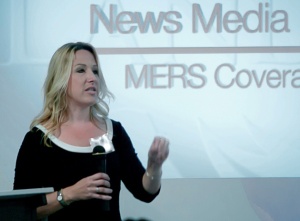
Bryan Harrold, vice president of CCH Marketing + Public Relations spoke about the social media impact of MERS. Orlando Health had more than 140,000 media impressions during the crisis and more than 60,000 Facebook users visited its page. Bryan shared that existing social media policies and procedures outlined who would post and provided a script to follow.
Katie also shared some best practices when dealing with a crisis situation like this. She recommended identifying multiple staging areas for media trucks and being able to explain why staging areas were needed. For example, a videographer jumped a fence to film on a helicopter landing pad and a satellite truck was stationed outside the hospital. During the first two days of the MERS crisis, “We took every interview request,” Katie said. Having a bilingual infectious disease specialist, Dr. Antonio Crespo, was ideal for interviews with CNN and CNN Latino. After the second day of the crisis, the hospital provided fewer interviews and published statements to better control and not over-saturate the message.
A CLEAN BILL OF HEALTH: PROVEN GOVERNMENT RELATIONS STRATEGIES
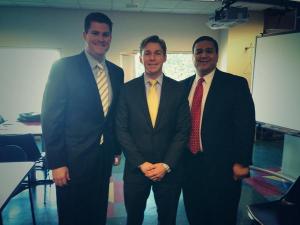
After surveying our members, we found like many of them wanted to learn more about government relations and interacting with elected officials and legislators. One of the morning’s first sessions featured a panel of three: Chris Carmody and Robert F. Stuart, Jr. from the law offices of Gray Robinson and FPRA member and Longwood County Commissionee Joe Durso. Joe also serves as the VP of community affairs for Community Based Care of Central Florida.
The trio highly stressed the importance of owning and controlling your message. Different audiences require differently tailored messages. Get out and speak to local community groups such as Rotary, Chambers of Commerce and Kiwanis Clubs. Share with them about your agency/cause. They’ll be the ones to talk to local elected officials about your issues. Listen to the community. Find out what they care about. In the same regard, schedule meetings with key leaders in your industry. Ask questions and learn what they’re passionate about. This will help you position yourself as the source of information for legislators, instead of the media. Be the person that legislators come to for the truth.
JUMP-STARTING YOUR INNER CREATIVE BY STARTING WITH THE “WHY”
In the next room over, a session was led by Chelsea Yaw, digital strategist with Purple, Rock, Scissors (PRPL), an Orlando-based digital creative agency. Chelsea’s presentation dealt with using goals and purpose to develop creative strategies. Goals are the “why” that lead to better tactics and strategies. Because of these goals, strategies, tactics and budgets can be justified. She referred to the Simon Sinek video “How Great Leaders Inspire Action” explaining that most companies know what they do and how they do it. However, great companies and great leaders know why they do it.
Fan
When you get a great idea you often have to sell it to someone. “Make sure that your tactics align with goals. Everything is tethered to the why,” she said. By mapping your idea to goals, you can better explain why your idea aligns with business goals. As a visual learner, she uses wall charts to track goals, strategies and tactics. Mapping these out provides a wider lens to see the project. Then you can develop better tactics to reach target personas. Chelsea suggested writing the full story before making the pitch. Make it really easy for journalists. Let them know that you a have a story, and that you would like to give it to them.
FANTASTICAL ESCAPISM
The second round of breakout sessions brought us back to our youth with a presentation from Phil Royle, resort product excellence manager for LEGOLAND Florida. In the competitive world of Central Florida theme parks, LEGOLAND Florida has found a unique way to stand out and draw the masses out to Winter Haven in Polk County. The best way to shape your brand is to put on your “brand goggles” and see from your customers’ point of view. In the case of LEGOLAND, this is younger children aged 2 to 12.
Phil shared how the company strives for “fantastical escapism” – something imaginative, energizing, crosses you into another world, allowing you to leave your troubles behind. “Leaks” are things that let the brand down and don’t fit the theme. For example, LEGOLAND feels a bit like Vegas because there are no clocks in the park. The presence of these reminds you that you need to beat the traffic and get home. “You always have an opportunity to make something more on brand,” says Phil. A “hot spot” is something that really enforces the brand. For example, in the soon-to-be LEGOLAND Florida Resort, cleaning carts won’t be ordinary. They’ll be themed to look like a shark or whale.
LEGOLAND realizes that children are its best brand ambassadors. They know the LEGO brand better than anyone. That’s why they train kids to do media interviews and to work as “Junior Concierge” at the resort. Phil challenged the audience to make their companies, offices and lives more fantastical and more on brand.
STRATEGIC PLANNING AND SOCIAL MEDIA MEASUREMENT
Across the hall, Dr. David Painter, public relations Master’s program instructor at Full Sail University confessed that he tends to reverse engineer everything to the “why” by asking, “What is the goal for the content?” However, goal setting should come first. Goal setting and measurement is one of the Barcelona Principles adopted by the International Association for Measurement and Evaluation of Communication and the Institute for Public Relations. Dr. Painter teaches students the importance of content creation. He shared ideas on how to improve outcomes by creating content across a wide spectrum of channels. For example, one of his students developed a website for a client with an online media room full of content. “Lots of content has to be developed to become a thought leader,” he said. The content should be aligned with business goals by setting qualitative figures for specific goals. For example, 100 Facebook likes could be a goal.
YouTube is the second most popular search engine behind Google. As public relations professionals, “We have to start creating video content. It’s time for PR people to own communications and not be under the marketing department.” Dr. Painter encourages students to create “how-to videos”, PSAs and visual presentations. He shared a sample student video using children to promote science, technology, engineering and math careers for women.
Sandra Krasa BK, also a public relations Master’s program instructor at Full Sail University spoke about PR and marketing strategies. She is an entrepreneur with two travel businesses in Nepal. She found evidence to support that public relations dominates the marketing funnel. “How much would 35,000 views cost on social media versus traditional media?” she asked.
A customer once said to her, “Give me a refund or I’ll give you a bad review on Trip Advisor.” She made the refund. In similar situations, she recommended using the Listen, Emphasize, Apologize and Problem Solve (LEAP) response to customer complaints. Sandra recommended using thinkwithgoogle.com for online data, analysis and insights. Using this tool, she found that social media assisted in making sales but did not lead to direct sales. “Don’t sell on social media,” she said. It is a place to let people know where to find your URL. Analytics showed that most of the sales came from direct URL links.The results of business interactions on social media are a kind of return on investment. Most people want to know what other people are saying about your service or product. So, it is vital to nurture relationships with brand advocates on social media.
SUSTAINING VIRAL CAMPAIGNS – THE ICE BUCKET CHALLENGE
For the keynote presentation, we heard from Alissa Gutierrez, director of marketing and communications with the Florida Chapter of the ALS Association. In August 2014, the ALS Foundation raised millions of dollars from a viral “Ice Bucket Challenge” video fundraising campaign.
Alissa began by sharing photographs of a friend diagnosed with Amyotrophic Lateral Sclerosis (ALS), also known as Lou Gehrig’s Disease, an illness that affects nerve cells in the brain and spinal cord. In two years, he went from being healthy to on a feeding tube. Today, he cannot walk and is losing the ability to speak. Life expectancy for ALS patients once diagnosed is about two to five years. There are about 30,000 people with ALS in the U.S. at any given time. It’s been 75 years since Hall of Fame baseball player Lou Gehrig gave his farewell speech at Yankee stadium. Since that time, little has changed. If you are diagnosed with ALS, you will hear the same thing they told Lou – “We don’t know the cause. There’s nothing we can do.” The only difference today is that you would be “getting a better wheelchair,” said Alissa. A power wheelchair equipped for ALS can cost $20,000 to $40,000. “This was a forgotten disease. “Many people do not even remember Lou Gehrig,” she said.
And then there was Chris Kennedy. He is reportedly the first person to record a video Ice Bucket Challenge. Next was Pete Frates, a former Boston College baseball player with Lou Gehrig’s Disease who made a video at Fenway Park in Boston. He asked his friends to dump water on their heads or make a donation to the ALS. More than 17 million similar Ice Bucket Challenge videos were posted on Facebook. “Even my dad did it. I think this is where fundraising is in the next decade,” Alissa shared. The national ALS office reported more than $115 million dollars in revenue.
After writing a press release about the Ice Bucket Challenge, Alissa started getting calls from the media. For two weeks in August she worked 19 hour days. “I made 52 media interviews in one day. It’s like nothing I’ve ever experienced in my entire career. The month of August felt like a year,” she said.
The National ALS office reported that $21 million would be allocated for research. According to Alissa, the revenue provided by the challenge is a “game changer” for research. What is the value of hope that a cure is coming? The funds will pay for research projects that would have gone unfunded. The ALS office plans to follow up and invite thousands of first-time donors to get more involved through newsletters, emails and magazines.
The challenge raised approximately $490,000 for the Florida Chapter of the ALS Association. A network news crew reported negatively on the disparity between revenue received by the National and Florida Association. “I learned that the media is not your friend. But many people are going to be helped with the additional funds for ASL research,” she said. When all is said and done, it is the responsibility of the PR professional to provide journalists with the right story.
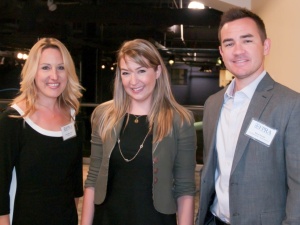
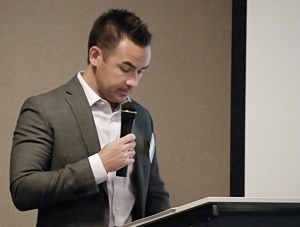

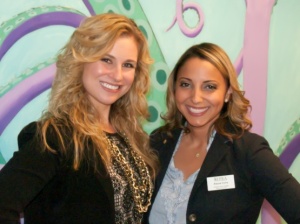
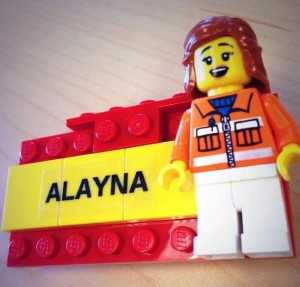
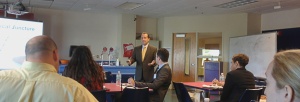

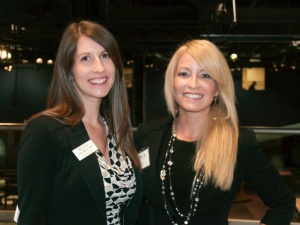
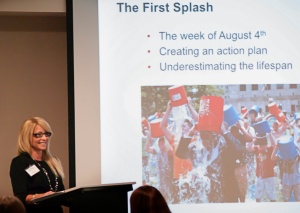



 Posted by fpraorlando
Posted by fpraorlando 

